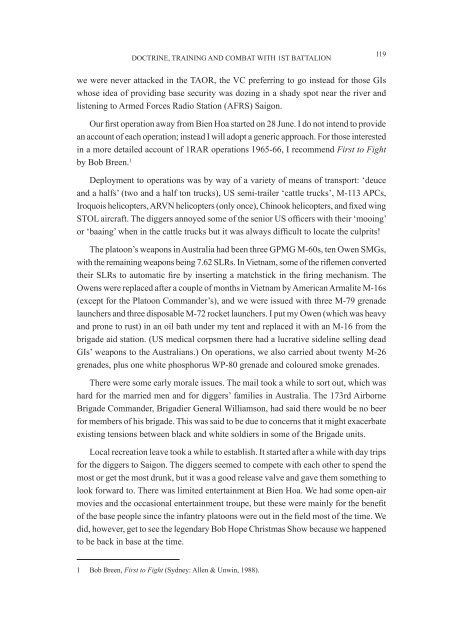conference proceedings - Australian Army
conference proceedings - Australian Army
conference proceedings - Australian Army
Create successful ePaper yourself
Turn your PDF publications into a flip-book with our unique Google optimized e-Paper software.
dOCTRINE, TRAININg ANd COMBAT WITH 1ST BATTALION<br />
we were never attacked in the TAOR, the VC preferring to go instead for those GIs<br />
whose idea of providing base security was dozing in a shady spot near the river and<br />
listening to Armed Forces Radio Station (AFRS) Saigon.<br />
Our first operation away from Bien Hoa started on 28 June. I do not intend to provide<br />
an account of each operation; instead I will adopt a generic approach. For those interested<br />
in a more detailed account of 1RAR operations 1965-66, I recommend First to Fight<br />
by Bob Breen. 1<br />
deployment to operations was by way of a variety of means of transport: ‘deuce<br />
and a halfs’ (two and a half ton trucks), US semi-trailer ‘cattle trucks’, M-113 APCs,<br />
Iroquois helicopters, ARVN helicopters (only once), Chinook helicopters, and fixed wing<br />
STOL aircraft. The diggers annoyed some of the senior US officers with their ‘mooing’<br />
or ‘baaing’ when in the cattle trucks but it was always difficult to locate the culprits!<br />
The platoon’s weapons in Australia had been three gPMg M-60s, ten Owen SMgs,<br />
with the remaining weapons being 7.62 SLRs. In Vietnam, some of the riflemen converted<br />
their SLRs to automatic fire by inserting a matchstick in the firing mechanism. The<br />
Owens were replaced after a couple of months in Vietnam by American Armalite M-16s<br />
(except for the Platoon Commander’s), and we were issued with three M-79 grenade<br />
launchers and three disposable M-72 rocket launchers. I put my Owen (which was heavy<br />
and prone to rust) in an oil bath under my tent and replaced it with an M-16 from the<br />
brigade aid station. (US medical corpsmen there had a lucrative sideline selling dead<br />
GIs’ weapons to the <strong>Australian</strong>s.) On operations, we also carried about twenty M-26<br />
grenades, plus one white phosphorus WP-80 grenade and coloured smoke grenades.<br />
There were some early morale issues. The mail took a while to sort out, which was<br />
hard for the married men and for diggers’ families in Australia. The 173rd Airborne<br />
Brigade Commander, Brigadier general Williamson, had said there would be no beer<br />
for members of his brigade. This was said to be due to concerns that it might exacerbate<br />
existing tensions between black and white soldiers in some of the Brigade units.<br />
Local recreation leave took a while to establish. It started after a while with day trips<br />
for the diggers to Saigon. The diggers seemed to compete with each other to spend the<br />
most or get the most drunk, but it was a good release valve and gave them something to<br />
look forward to. There was limited entertainment at Bien Hoa. We had some open-air<br />
movies and the occasional entertainment troupe, but these were mainly for the benefit<br />
of the base people since the infantry platoons were out in the field most of the time. We<br />
did, however, get to see the legendary Bob Hope Christmas Show because we happened<br />
to be back in base at the time.<br />
1 Bob Breen, First to Fight (Sydney: Allen & Unwin, 1988).<br />
119

















